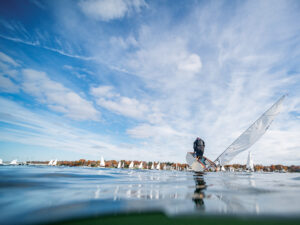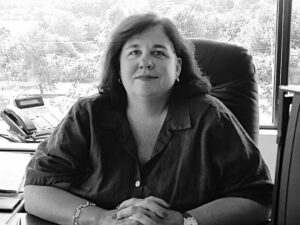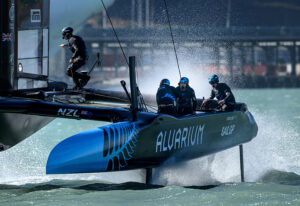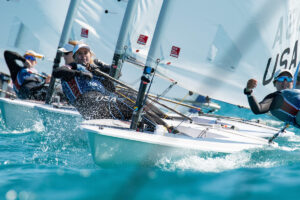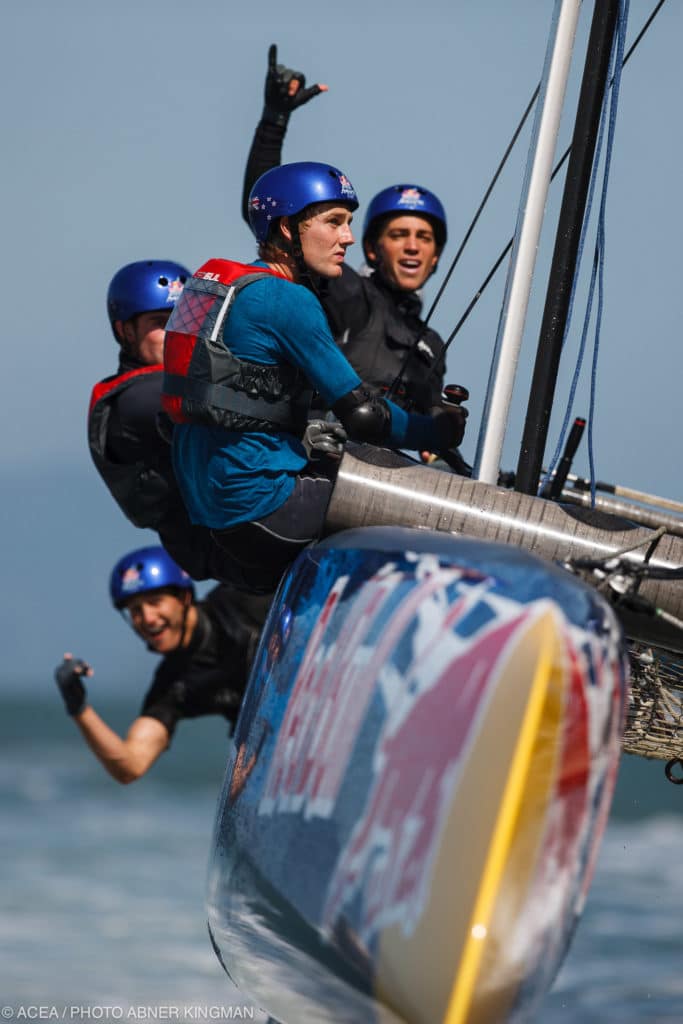
Red Bull Youth America’s Cup
Contrary to popular belief, sailing is no stranger to the extrovert energy drink giant Red Bull. In fact, it’s one of the longest standing disciplines in the company’s mixed portfolio of sports, says Hans Peter Steinacher, one of its longtime sailing athletes. Red Bull, which has been around since 1987, brought sailing on board in 1993, and shortly thereafter hired Austrians Steinacher and his longtime sailing partner, Roman Hagara, double Olympic Gold medalists in the Tornado catamaran to both compete and run its sailing program. “That we were double gold medalists in the catamaran class fit with Red Bull as they always sponsor sailing boats that fly a hull,” says Steinacher.
Fast forward to AC34: Red Bull has come on board as the helmet sponsor for Oracle Team USA, and Russell Coutts has lost no time selling his idea for a Youth America’s Cup to Red Bull. “For Red Bull, the America’s Cup was always about old people and very experienced sailors, so we knew we had to do something for the youth as well. That’s how the Youth America’s Cup came about,” explains Steinacher, 44, who shares the role of sports director for the Red Bull Youth America’s Cup with Hagara. The event, which is widely expected to be the highlight of the 34th America’s Cup, runs from September 1 through 4, with eight fleet races scheduled.
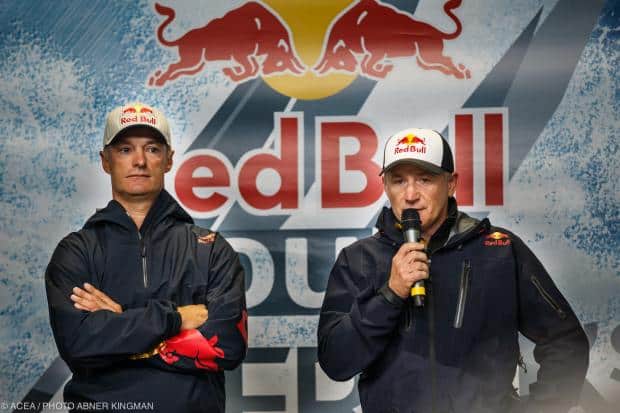
ACEA/Abner Kingman
Hans Peter Steinacher and Roman Hagara talk to the RBYAC Sailors
Is this event ready to go?
HPS: Yes, we have all ten boats on the water and actually we could start tomorrow if we needed to.
What’s been the biggest challenge pulling it all together?
HPS: The 10 boats. The boats cost $1 million, and you get them from the teams. To go to the teams and say, “We’re using your boat,” you have to be sure to return it in the same condition that you received it. We’ve spent a lot of time talking with the teams and sharing our training plans, which had the youth teams start slowly for a very long period for training so that they get used to the boat.
Have the teams had enough time to train?
HPS: More than enough. We’ve now had our third day of training on the water. It’s already looking very professional. On the boat, the guys know what’s going on. They have a better feeling now of what they can risk and what not. The next 12 days will be more training, and they’ll be ready for racing.
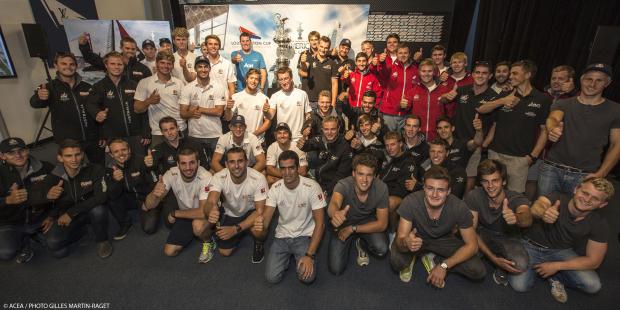
ACEA/Gilles Martin-Raget
Red Bull Youth America’s Cup teams
What’s your impression of the standard?
HPS: We selected 10 teams out of 40; these are the best that we could find in the world. I’m quite impressed with how good they are with their skills. The only big issue for them is that they’re not used to working together. They have six young guys on board–normally they’re sailing with one other person maximum, so they don’t talk a lot. They’re not communicating, that’s their biggest issue. And, they don’t think in advance. The little dinghies or catamarans that they are sailing–most of them are sailng 49ers–most of the time they don’t have to say anything, like “tacking in three seconds.” They just do it–pull the rudder and that’s it. You just can’t do that on boats like this. You have to prepare the runner, you have to prepare the winches, and so on. It’s not a big deal, just interesting to observe. It’s the same with all the teams.
Have you started practicing fleet starts?
HPS: This is coming up in the next few days. We’ll do the first few without pressure, just to get time and distance figured out.
What happens with the event for Red Bull after September 4?
HPS: The plan is to continue with the Red Bull Youth America’s Cup, done only in conjunction with the America’s Cup, always the event prior to the final match. But we have programming for the years in between. We like to stay with the good people, we like to help them with their Olympic programs, we like to give them a chance to race on the Extreme sailing circuit or if the AC45 circuit comes up, we can do it there, too. We like to pick the best sailors out of these 60 and say, “We give you the opportunity to race with Red Bull.” It’s interesting, I’ve talked with all of them, and they all want to be sailing professionals in the future. Not one said, “I’m doing this now, and in two years when I’m done with my university I’ll do something different.” They are all fully focused into sailing.
How many would you take?
HPS: It is really program-driven more than anything, depending on what we have going on. We’d like to choose for sure some of the young ones for our Extreme 40 boat for next year. Maybe we’ll have two Extreme 40 boats next year and take 12 to 15 guys out of here.
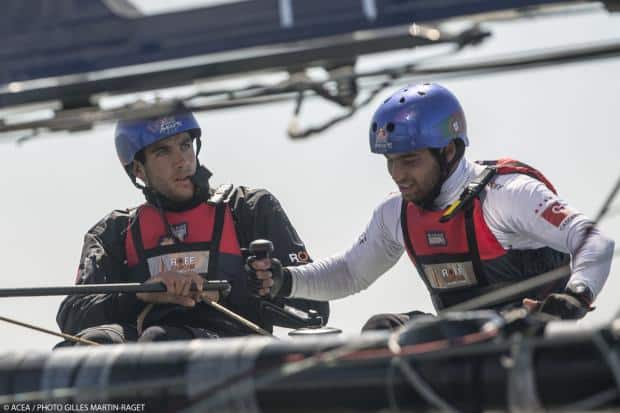
ACEA/Gilles Martin-Raget
Roff-Cascais Sailing Team (POR) gets focused.
******Do you know what’s going to happen with the AC45s long term?
HPS:** No one knows. Everyone loves the boats, but nobody actually knows what’s going on with them yet. Red Bull is an energy drink company, not a sailing event company, so any event we get involved with has to be done by a professional organization, like ACRM, so Red Bull can just step in as a sponsor.
Has there been concern from Red Bull about the state of AC34?
HPS: No, the reason why the America’s Cup is so successful for Red Bull is because we went back to the original thing from the America’s Cup: The six guys on the boat are passport holders from the same country. If New Zealanders see their boat sailing and know there are six Kiwis on board, that’s very important to us. You know who is who; I think the nationality aspect of the Cup in the past is important and how it should be.
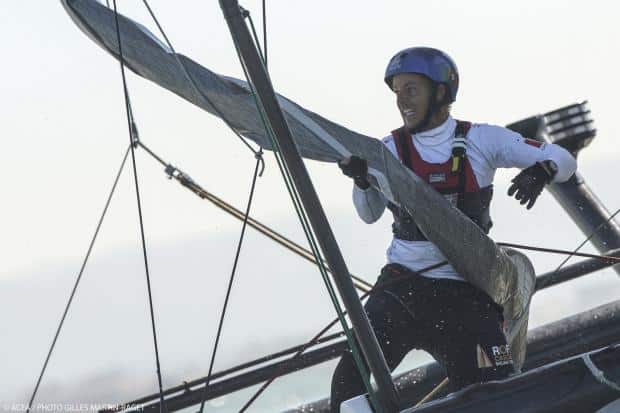
ACEA/Gilles Martin-Raget
How will Red Bull make the Youth Series its own event?
HPS: We didn’t want it to be the Red Bull Cup, that’s not what we were after. We like to showcase the countries–see how the wings are branded? The biggest image on the wing is the country flag. The youth is the other important thing for Red Bull, that the people see that the guns on board are between ages 19 and 24. As for the event, we’ll race from 11:15 a.m. to 1 p.m. daily, the boats will all be moored at the Marina Green, and after racing, the guys will be mixing it up with the public spectators on the Marina Green.
Is four days of racing enough?
HPS: Yes. We are training now, our practice race days will be the three days prior to racing. It’ll look cool, like the normal event. It’s practice for the boys, as they won’t have an opportunity to train with Liveline and the electronic boundaries before then, as they won’t have full electronics on board until August 26.
The issue with the Oracle boats and “weight-gate,” has that affected anything from where you’re standing?
HPS: Well, it started with us. We took the boats out of the container, the boys put everything together, and they controlled everything because we like to completely set the boats up for the Youth AC, and that’s how we found the problem.
It’s a really little thing, I don’t know why they did it. I didn’t speak with Russell about these things; they have to figure it out. One thing is for sure, it’s not an advantage at all. But, it’s also not allowed. The number one rule of sailing is not to make the boat slower, so to put something somewhere so that the boat is slower–there must be a reason they put it there?
Which of these teams are standing out to you?
HPS: It looks like Peter Burling on Team NZ is quite strong because he’s already sailed here at the World Series last year. He was helming Team Korea, so he has some experience. But we will see. There are some really good helmsmen with a lot of feeling, and they can sail the boat really quickly. He’s actually the favorite. The other teams like it–they all chase him!
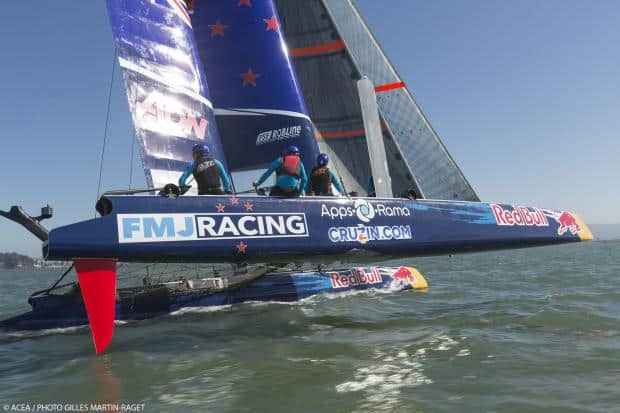
ACEA/Abner Kingman
Full Metal Jacket Racing (NZ)
You & Roman raced in the World Series in Naples earlier this year. What do you like about the 45s?
HPS: It’s an excellent boat; it’s very nice to sail. You have a lot of power in the wing, and you have to learn to sail the boat fast because you have asymmetric foils. It’s all about speed. Speed the thing up and you are good.
With your sailing background, why aren’t you on an AC72?
HPS: On the 72 you need 11 sailors, and you need a lot of experience, mainly how to work with such a big team. When you look at the teams, 99 percent of them speak English. The crew must communicate together on board the right thing at the right time; you have to understand everything very clearly. The only team that is a little different is Prada. They’re mixed up because it’s mainly an Italian team, but Oracle, ETNZ–they’re fully English-speaking.
I grew up in a ski resort close to Salzburg in Austria. We have a nice little lake nearby. I didn’t start sailing until I was 16 years old. So I started late into sailing and stayed a very long time in the Olympic classes. These teams aren’t hiring you with no experience when you are nearly 40. They hire you if you are 26 with no experience, and they know you are a good sailor because you have time to learn. By the time you are 40, you should already have experience on the big boats, but that’s what we are missing in Austria. We have no big boats. How can you sail big boats when you have only small lakes? We are the first in Austria who went into this big boating, never before have Austrians sailed big boats or had a big boat team. The Red Bull Extreme 40 is the biggest and fastest boat sailing in Austria.

